
Auschwitz II - Birkenau |
||
|

|
Dr. Josef Mengele, the notorious doctor who selected Jews for the gas chamber at the Birkenau death camp, is shown in the center of the photo above. On his left is Richard Baer, the last commandant of the Auschwitz main camp and on his right is Rudolf Hoess, the former commandant of the Auschwitz complex from 1940 to 1943, and the commandant of the SS garrison at Auschwitz in 1944. According to the book entitled "Mengele, the Complete Story," by Gerald L. Posner and John Ware, Dr. Josef Mengele spent 21 months at the Auschwitz-Birkenau camp, and during that time, he sent 400,000 prisoners to their deaths in the gas chambers at Birkenau. Allowing for the time that Dr. Mengele could not work when he was sick with malaria and typhus, he selected 20,000 Jews and Gypsies per month to be killed, according to Posner and Ware. The following quote is from "Mengele, the Complete Story": The memory of this slightly built man, scarcely a hair out of place, his dark green tunic neatly pressed, his face well scrubbed, his Death's Head SS cap tilted rakishly to one side, remains vivid for those who survived his scrutiny when they arrived at the Auschwitz railhead. Polished boots slightly apart, his thumb resting on his pistol belt, he surveyed his prey with those dead gimlet eyes, Death to the left, life to the right. Four hundred thousands souls -- babies, small children, young girls, mothers, fathers, and grandparents -- are said to have been casually waved to the lefthand side with a flick of the cane clasped in a gloved hand. Mengele was the chief provider for the gas chambers and their crematoria. He had a look that said 'I am the power,' said one survivor. At the time, Mengele was only 32 years old. Although most survivors of Auschwitz say that those selected to live were directed to the right, as mentioned in the above quote from "Mengele, the Complete Story," there was at least one person who was sent to the left and lived. Most Holocaust historians say that Jews younger than 15 were immediately sent to the gas chamber at Auschwitz, but 13-year-old Ann Feig Rosenheck was an exception; she was sent to the left and was the only person in her family to survive. According to this news article, Rosenheck's story is as follows: Rosenheck was taken with her sister, her sister's children and her mother and placed in a line. They came before Josef Mengele, a doctor at Auschwitz nicknamed the "angel of death." He ordered the 13-year-old to go left and her mother, sister and her sister's children to go right. "I walked off to the left, and they walked off to the right," she said. "They went straight into the gas chamber. I on the other hand was brought into a barrack." Rosenheck was eventually moved to a camp at Dachau, where she was liberated by American forces on April 29, 1945. She was 14. There are two famous stories about Dr. Josef Mengele: one about his attempt to change brown eyes to blue and one about sewing two children together, back to back, to create Siamese twins. Vera Alexander, a survivor of Birkenau, was a witness to the Siamese twins experiment. Dr. Mengele had died in 1979 but his death was kept a secret by his friends and family. In October 1985, while an intensive manhunt for Mengele was underway, Vera Alexander said the following in an interview for the TV production "The Search for Mengele," as quoted in the book "Mengele, the Complete Story": One day Mengele brought chocolate and special clothes. The next day, SS men came and took two children away. They were two of my pets, Tito and Nino. One of them was a hunchback. Two or three days later, an SS man brought them back in a terrible state. They had been cut. The hunchback was sewn to the other child, back to back, their wrists back to back too. There was the terrible smell of gangrene. The cuts were dirty and the children cried every night. According to Gerald L. Posner and John Ware, the authors of "Mengele, the Complete Story," Mengele had already made a bizarre start in his attempt to change brown eyes to blue before the arrival of Dr. Miklos Nyiszli, a Hungarian Jewish doctor, on May 29, 1943. Dr. Nyiszli was selected to assist Dr. Mengele by doing autopsies on the corpses in Crematorium II or Krema II. Dr. Mengele had a particular interest in studying people who had eyes of two different colors. The story of the eye color experiment on 36 children in Birkenau was told by Dr. Vexler Jancu, a Jewish prisoner at Birkenau. As quoted in "Mengele, the Complete Story," Dr. Jancu said the following: In June 1943 I went to the Gypsy camp in Birkenau. I saw a wooden table. On it were samples of eyes. They each had a number and a letter. The eyes were very pale yellow to bright blue, green and violet. Dr. Mengele escaped from Auschwitz before the camp was liberated by the army of the Soviet Union, and he took all of his research papers with him. These papers later fell into the hands of the Allies, but they have never been published. The results of Dr. Mengele's experiments are currently being held in a vault in Israel. The testimony of some of the Jews, who were the subjects of his experiments or research, has been published, but not the results of Dr. Mengele's experiments, nor his research papers on Jewish genetic conditions and diseases. There were allegations by several survivors of Birkenau that Dr. Mengele had 300 children burned alive in an open fire. As quoted in the book "Mengele, the Complete Story," a Russian inmate of Birkenau named Annani Silovich Per,ko said the following in a sworn statement made to the State Prosecutor, Moscow, on September 1973: After a while a large group [of SS officers] arrived on motorcycles, Mengele among them. They drove into the yard and got off their motorcycles. Upon arriving, they circled the flames; it burned horizontally. We watched to see what would follow. After a while, trucks arrived , dump trucks with children inside. There were about ten of these trucks. After they had entered the yard, an officer gave an order and the trucks backed up to the fire and they started throwing those children right into the fire, into the pit. The children started to scream; some of them managed to crawl out of the burning pit; an officer walked around it with sticks and pushed back those who managed to get out. Hoess and Mengele were present and were giving orders.  The following quote is from a book entitled "The Criminal Mind" by Dr. Katherine Ramsland who wrote 25 books on criminal psychology: Besides bureaucrats and the military, Hitler also inspired some doctors to serve his horrific vision, most notably Auschwitz's Angel of Death, Josef Mengele. A leader in the Nazi biomedical vision, he thrived on experiments with genetic abnormalities. Arriving in Auschwitz on May 30, 1943, he took charge of the "selections" process. He'd show up at the prisoner transports looking quite elegant and at a glance would decide each person's destiny. He sent anyone with an imperfection to the gas chamber and singled others out for work or for his nefarious experiments. Mengele enjoyed his powerful position. To uphold the Nazi ideal of racial purification was his driving motivation. Yet no one quite knew what to expect from him. Even as he separated families and killed with impunity, he might step into the role of concerned physician or whimsically allow some people to live. In his desire to improve the efficiency of the camp as a killing machine, he taught other doctors how to give phenol injections to a long line of prisoners, quickly ending their lives. He also shot people, and by some reports he tossed live babies into the crematoria. Throughout all of this, he kept a detached, efficient demeanor and viewed himself as a "scientist." Mengele's great passion was his research on twins. They were weighed, measured, and compared in every way. Some he would kill for pathological examinations, dissecting a few and keeping parts preserved. Others he might operate on without anesthesia, removing limbs or sexual organs. If one twin died during these experiments, the other was no longer of use, so he or she was simply gassed. Yet even as he targeted them for mutilation or death, he'd play with them and show great affection. He even gave them a ride in his car on their way to the gas chamber. Afterward, he might walk around with their heads or pin their eyes to a bulletin board. By May 1944, a railroad spur line, which split off from the main railroad tracks, had been extended all the way inside the Birkenau camp so that the Hungarian Jews could be brought right up to the gas chambers in Krema II and Krema III, which were located on either side of the tracks. On May 16, 1944, several freight trains arrived at Birkenau and the Hungarian Jews were gassed immediately without undergoing a selection process, according to Danuta Czech who wrote "The History of KL Auschwitz," published in Poland in 1967. The Hungarian Jews on subsequent transports were kept in a transit camp at Birkenau for a few days, and without being registered, were then sent to work in the munitions factories in the eleven Kaufering sub-camps of Dachau, or in the airplane factories at Mauthausen in Austria. Some of the women were sent to Allendorf, a sub-camp of Buchenwald, where they worked in munitions factories. Only 28,000 Hungarian Jews were registered at Auschwitz, according to the director of the Auschwitz Museum. The photo below, taken in May 1944, shows a transport of 3,500 Hungarian Jews who have just disembarked from a train. In the background, the tall chimneys of Krema II on the left and Krema III on the right can be seen. The Krema III building is about one inch from the edge of the photo on the right-hand side. The gas chambers and ovens in Krema II and III had the capacity to gas and burn more than 2,000 Jews from a transport. One of the Hungarian Jews who arrived in Birkenau in May 1944 was Irene Zisblatt; she survived and wrote a book entitled "The Fifth Diamond." The following quote is from a newspaper article written by Nate Hubbard after Irene Zisblatt gave a talk to students in Bland County, Virginia on March 9, 2009: But the most gripping part of Zisblatt's account came when she told of narrowly escaping the gas chamber. She said she was selected along with approximately 1,500 other women to be killed. When the prisoners were herded into the gas chamber, though, there wasn't room for them all. Zisblatt said she wound up right in the doorway, clinging to a piece of wood as her fingernails were ripped off causing blood to gush from the tips of her fingers. When the door couldn't be closed with Zisblatt blocking the way, she was flung out of the chamber. With the help of another prisoner, she said she was able to escape Auschwitz by getting on a train traveling across tracks running near the No. 3 gas chamber. The train took her to the Neuengamme labor camp in Germany where shortly after she was forced to go on a "death march" as the war wound down. Irene Zisblatt had been saved by a young Sonderkommando (Jewish crematorium worker) who rescued her after she was thrown out of the Krema III gas chamber because the room was too full. He wrapped her in a blanket and tossed her over the 10-foot-high barbed wire fence around Krema III; she landed in an open railroad car of a train that was bound for the Neuengamme concentration camp in Germany. The photo below, taken at Birkenau in May 1944, shows how the Jews from a transport were first ordered to line up in two columns, with the men in one line and the women and children in another line. Each column had to march past the SS officers during the selection process. Those who were unfit for work were sent immediately to the gas chambers. In the photo below, Krema II and Krema III are behind the camera and only a short distance from the head of the two columns. In the background is the tower of the gate house at Birkenau. Notice that there are no guard towers along the main camp road, which is on the right in the photo. On the left is the train that was used to transport these 3,500 Jews to Birkenau. Across from the train on the right side of the photo is the women's camp and at the end of the main camp road is the location of Krema II and Krema III. Dr. Mengele is one of the two SS officers standing in front of the line of men; he is the one on the right, holding a cigarette at chest height. 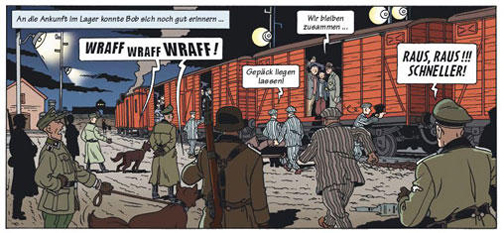 The photo immediately above, from a Comic book recently introduced in German elementary schools, shows what it was really like when the Jews arrived at night in Birkenau. The old black and white photos on this page were taken by the Nazis when a transport of Hungarian Jews arrived on May 26, 1945; notice that the SS men, shown in the old photos, were on their best behavior and there were no vicious dogs barking, nor guns pointed at the prisoners. The gate into the Birkenau camp is shown in the background of both pictures. From all over Europe, Jews were brought by train to Auschwitz-Birkenau, mostly in cattle cars. According to Olga Lengyel, a doctor who was a prisoner at Birkenau, the new arrivals went through a selection process during which 30 SS officers took turns selecting workers for the factories and sending those who were too young or too old to the gas chamber with a wave of the hand. To the left meant immediate death in the gas chamber; to the right meant a few months of slave labor, living in miserable conditions, and barely subsisting at a starvation level. In her book entitled "Five Chimneys," Lengyel wrote that Dr. Fritz Klein was the "Chief Selector." She described Dr. Klein as "different from the other S.S. He never shouted and had rather nice manners." Dr. Klein had arrived at Auschwitz-Birkenau on December 15, 1943; he first served as a camp doctor in the women's camp in Birkenau. Later, Dr. Klein worked as a camp doctor in the Gypsy camp at Birkenau. In December 1944, Dr. Klein was transferred to Neuengamme concentration camp; he was sent to the Bergen-Belsen concentration camp in January 1945, where he was arrested by the British in April 1945. Dr. Fritz Klein was put on trial by the British after the war, charged with committing war crimes at both Birkenau and Bergen-Belsen; he was sentenced to death and hanged on December 13, 1945.  The photo above shows two women who have just gone through the selection process. They are headed north, down one of the two north-south roads that lead to the Krema IV and Krema V gas chambers, and also to the Central Sauna where those who were selected for work will be disinfected and then have a shower. The Krema IV & V gas chambers, disguised as shower rooms, are just beyond the Sauna building. Video of tour guide at Birkenau explaining the selection process. 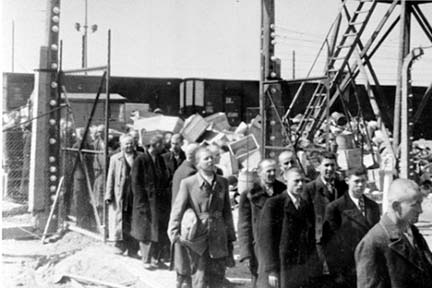 In the photo above, men who have been selected for slave labor walk north, through a gate in the center of the Birkenau camp, headed for the shower room in the Central Sauna. In the photo below, Hungarian women and children walk north, past the men's barracks, on their way to being gassed in the fake shower rooms in Krema IV and Krema V. They are on the same north-south road as the men in the second photo below, who are walking to the Sauna for a shower. Note the transport train in the background. The woman on the far left in the photo below is Bracha Junger. 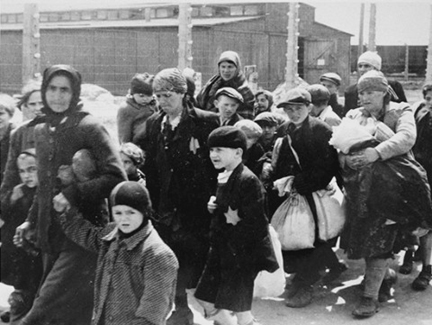 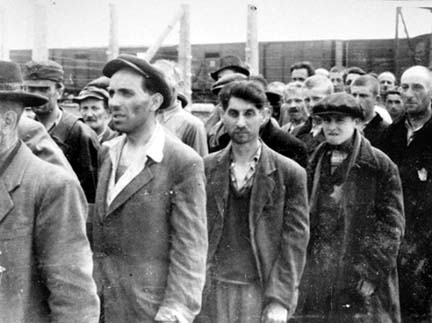 Twins or family members who had the same congenital defect, such as a hunch back or a club foot, were pulled out of the line to be used as subjects for Dr. Josef Mengele's medical research on genetic conditions and hereditary diseases. 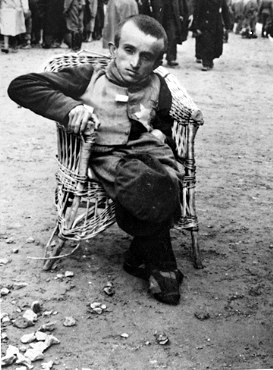 From one of the Hungarian transports in 1944, the Ovitz family, consisting of seven dwarves, two children, and their normal-height sisters, were saved because Dr. Mengele wanted to study them. In all, 23 Jews from the town of Rozavlea in Transylvania survived; another family from the town was saved after they claimed that they were related to the Ovitz family. Holocaust survivor Jack Adler was 15 years old when he and his family were sent from the Lodz ghetto in what is now Poland to the death camp at Auschwitz-Birkenau in 1944. The following quote is from a news article on the "Fort Collins: Now" web site on the occasion of a speech given by Jack Adler to students at Colorado State University in March 2008 during Holocaust Awareness Week: As the prisoners unpacked from boxcars, the selection process began. The old, sick and young were ordered to move to the right and told they would be taking a shower, Adler recalls. Among them was Adler's younger sister who (sic) he had managed to protect for two years. After removing their clothes, they were herded into a gas chamber and killed. Adler said he just didn't understand why all this was happening. "It's very difficult unless you find yourself in someone's shoes," he said. "You just have one word to repeat to yourself. 'Why?' My family did not harm anyone. It shows you that those who preach hate plant the seed of evil." Adler himself came quite close to death on several occasions. When he first arrived, he was assigned to a particular barrack by Dr. Joseph Mengele, where the prisoners would be used as "medical" experiments. That first night, though, when he went to the latrine, he encountered one of his father's friends who brought him to his father's barracks. In the morning, the prisoners would be counted and assigned to work at various concentration camps. An officer discovered there were too many prisoners and ordered whoever didn't belong in those barracks to step forward. Adler stood in his place. After no one would step forward, the commanding officer walked up and down the row of prisoners and pulled out the youngest-looking to send back in Adler's place. After two weeks at Birkenau, Adler and his father were sent to the concentration camp of Kaufering, in Germany. A daily food ration consisted of a slice of bread in the morning and a bowl of soup at noon. Six months after Adler arrived at Kaufering, half of the prisoners were dead. When the camps were reorganized, Adler was separated from his father and sent to the concentration camp of Dachau, where he would remain until April 27, 1945, the day of the infamous "Death March." About 10,000 prisoners were marched out of Dachau, 2,000 at a time. Adler remembers that the tail end of each group would be chased off and shot with machine guns. Adler was one of the lucky 4,000 prisoners who made it from Dachau and was liberated on May 1, 1945. More about the selections at BirkenauPreviousAuschwitz III - aka MonowitzMonowitz gas chamber?Liberation of Auschwitz-BirkenauSurvivors of Birkenau campDeath StatisticsHistory of AuschwitzAuschwitz II - aka BirkenauHomeThis page was last updated on February 03, 2010 |